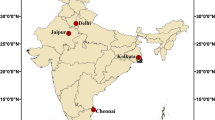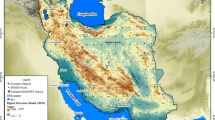Abstract
With the insidiously growing impact of urban development on the environment, the issue of air quality has attracted extensive attention nationally and globally. It is of great significance to study the influence of urbanization on air quality for the rational development of cities. MODIS-MAIAC (Moderate Resolution Imaging Spectroradiometer-Multi-Angle Implementation of Atmospheric Correction) Aerosol optical depth (AOD) product, DMSP/OLS (Defense Meteorological Satellite Program/Operational Linescan System) and NPP/VIIRS (Suomi National Polar-orbiting Partnership/Visible Infrared Imaging Radiometer Suite) night-light were used to explore the spatiotemporal variation and correlation between AOD and urbanization development before and after the promulgation of environmental governance policies in Jinan City from 2009 to 2018. Results show that (1) the spatial distribution of AOD in Jinan had the characteristics of high in the north and low in the south, high in the west and low in the east, and low in some parts of the central region; there was a significant seasonal variation in time, with the highest AOD in summer and the lowest in winter. During 2009–2013, the annual average variation of AOD increased by 20.6%, while during 2014–2018, it decreased by 35.3%; (2) The distribution of night-light in Jinan City has progressively expanded, mirroring the city’s ongoing development. The spatial distribution of aerosols in urban areas was relatively low compared to the surrounding areas of the city. (3) From 2009 to 2013, there existed a significant positive correlation between the spatial and temporal distribution of AOD and night-light. However, from 2014 to 2018, with the implementation of environmental governance policies, this relationship shifted to a significant negative correlation between the spatial and temporal distribution of AOD and night-light. Through an analysis of the correlation between urban development and aerosol depth in Jinan City over the past decade, it can be concluded that urban development does not inevitably result in elevated AOD levels. Notably, the Jinan government has achieved remarkable results in controlling the atmospheric environment, as evidenced by recent years’ improvements.









Similar content being viewed by others
Data availability
AOD data was from MODIS-MAIAC products (https://lpdaac.usgs.gov/), and the DMSP/OLS image data from the National Oceanic and Atmospheric administration (National Oceanic and Atmospheric Administration | U.S. Department of Commerce (noaa.gov)), NPP/VIIRS data were obtained from the National Geophysical Data Center (NOAA National Centers for Environmental Information (NCEI)). The land cover map was from Copernicus Global Land Cover Layers (CGLS-LC100) Collection 3 dataset (https://land.copernicus.eu/global/products/lc100).
References
Ali MA, Bilal M, Wang Y, Qiu Z, Nichol JE, de Leeuw G, Ke S, Mhawish A, Almazroui M, Mazhar U, Habtemicheal BA, Islam MN (2022) Evaluation and comparison of CMIP6 models and MERRA-2 reanalysis AOD against satellite observations from 2000 to 2014 over China. Geosci Front 13(2):101325. https://doi.org/10.1016/j.gsf.2021.101325
Dickerson R, Kondragunta S, Stenchikov G, Civerolo K, Doddridge B, Holben B (1997) The impact of aerosols on solar ultraviolet radiation and photochemical smog. Science 278(5339):827–830
Doll C, Muller J, Elvidge C (2000) Night-time imagery as a tool for global mapping of socioeconomic parameters and greenhouse gas emissions. Ambio 29(3):157–162. https://doi.org/10.1639/0044-7447(2000)029[0157:NTIAAT]2.0.CO;2
Estefany C, Sun Z, Hong Z, Du J (2023) Raman spectroscopy for profiling physical and chemical properties of atmospheric aerosol particles: a review. Ecotoxicol Environ Saf 249:114405–114405. https://doi.org/10.1016/j.ecoenv.2022.114405
He Q, Zhang M, Huang B (2016) Spatio-temporal variation and impact factors analysis of satellite-based aerosol optical depth over China from 2002 to 2015. Atmos Environ 129:79–90. https://doi.org/10.1016/j.atmosenv.2016.01.002
Kang M, Jung MC (2019) Night on South Korea: unraveling the relationship between urban development patterns and DMSP-OLS night-time lights. Remote Sens (Basel) 11(18):2140. https://doi.org/10.3390/rs11182140
Lawrence W, Imhoff M, Kerle N, Stutzer D (2002) Quantifying urban land use and impact on soils in Egypt using diurnal satellite imagery of the Earth surface. Int J Remote Sens 23(19):3921–3937. https://doi.org/10.1080/01431160110115951
Li H, Shi R, Jin S, Wang W, Fan R, Zhang Y, Liu B, Zhao P, Gong W, Zhao Y (2021a) Study of persistent haze pollution in winter over Jinan (China) based on ground-based and satellite observations. Remote Sens (Basel) 13(23):4862. https://doi.org/10.3390/rs13234862
Li K, Bai K, Li Z, Guo J, Chang N-B (2022) Synergistic data fusion of multimodal AOD and air quality data for near real-time full coverage air pollution assessment. J Environ Manage 302:114121. https://doi.org/10.1016/j.jenvman.2021.114121
Li L, Wang Y (2014) What drives the aerosol distribution in Guangdong - the most developed province in Southern China? Sci Rep 4(1):5972
Li X, Liu Y, Wang M, Jiang Y, Dong X (2021b) Assessment of the Coupled Model Intercomparison Project phase 6 (CMIP6) Model performance in simulating the spatial-temporal variation of aerosol optical depth over Eastern Central China. Atmos Res 261:105747. https://doi.org/10.1016/j.atmosres.2021.105747
Li Z, Wang Y, Guo J, Zhao C, Cribb MC, Dong X, Fan J, Gong D, Huang J, Jiang M, Jiang Y (2019) East Asian study of tropospheric eerosols and their impact on regional clouds, precipitation, and climate (EAST-AIR(CPC)). J Geophys Res Atmos 124(23):13026–13054. https://doi.org/10.1029/2019JD030758
Lin Y, Wang Y, Pan B, Hu J, Guo S, Levy Zamora M, Tian P, Su Q, Ji Y, Zhao J, Gomez-Hernandez M, Hu M, Zhang R (2022) Formation, radiative forcing, and climatic effects of severe regional haze. Atmos Chem Phys 22(7):4951–4967. https://doi.org/10.5194/acp-22-4951-2022
Ma T, Zhou C, Pei T, Haynie S, Fan J (2012) Quantitative estimation of urbanization dynamics using time series of DMSP/OLS nighttime light data: a comparative case study from China’s cities. Remote Sens Environ 124:99–107. https://doi.org/10.1016/j.rse.2012.04.018
McCoy I, Vogt M, Wood R (2022) Absorbing aerosol choices influences precipitation changes across future scenarios. Geophys Res Lett 49(8):e2022GL097717. https://doi.org/10.1029/2022GL097717
Ren X, Huang S, Wang J, Xu X (2022) The impact of urbanization on air quality in Africa from time and spatial perspectives. Environ Sci Pollut Res 29(49):74699–74714. https://doi.org/10.1007/s11356-022-21109-w
Riccobono F, Schobesberger S, Scott CE, Dommen J, Ortega IK, Rondo L, Almeida J, Amorim A, Bianchi F, Breitenlechner M, David A (2014) Oxidation products of biogenic emissions contribute to nucleation of atmospheric particles. Science 344(6185):717–721. https://doi.org/10.1126/science.1243527
Shi K, Yu B, Huang Y, Hu Y, Yin B, Chen Z, Chen L, Wu J (2014) Evaluating the ability of NPP-VIIRS nighttime light data to estimate the gross domestic product and the electric power consumption of China at multiple scales: a comparison with DMSP-OLS data. Remote Sens (Basel) 6(2):1705–1724. https://doi.org/10.3390/rs6021705
Sutton P, Roberts D, Elvidge C, Baugh K (2001) Census from Heaven: an estimate of the global human population using night-time satellite imagery. Int J Remote Sens 22(16):3061–3076. https://doi.org/10.1080/01431160010007015
Tian P, Cao X, Zhang L, Sun N, Sun L, Logan T, Shi J, Wang Y, Ji Y, Lin Y, Huang Z, Zhou T, Shi Y, Zhang R (2017) Aerosol vertical distribution and optical properties over China from long-term satellite and ground-based remote sensing. Atmos Chem Phys 17(4):2509–2523. https://doi.org/10.5194/acp-17-2509-2017
Tian P, Yu Z, Cui C, Huang J, Kang C, Shi J, Cao X, Zhang L (2023) Atmospheric aerosol size distribution impacts radiative effects over the Himalayas via modulating aerosol single-scattering albedo. npj Climate and Atmospheric. Science 6(1):54. https://doi.org/10.1038/s41612-023-00368-5
Wang J, Liu H, Liu H, Huang H (2021a) Spatiotemporal evolution of multiscale urbanization level in the Beijing-Tianjin-Hebei Region using the integration of DMSP/OLS and NPP/VIIRS night light datasets. Sustainability 13(4):2000. https://doi.org/10.3390/su13042000
Wang Q, Feng H, Feng H, Yu Y, Li J, Ning E (2021b) The impacts of road traffic on urban air quality in Jinan based GWR and remote sensing. Sci Rep 11(1):15512. https://doi.org/10.1038/s41598-021-94159-8
Wang X, Mu X, Yan G (2020) Quantitative analysis of aerosol influence on Suomi-NPP VIIRS nighttime light in China. IEEE J Sel Top Appl Earth Obs Remote Sens 13:3557–3568. https://doi.org/10.1109/JSTARS.2020.3003480
Wei Y, Liu H, Song W, Yu B, Xiu C (2014) Normalization of time series DMSP-OLS nighttime light images for urban growth analysis with Pseudo Invariant Features. Landsc Urban Plan 128:1–13. https://doi.org/10.1016/j.landurbplan.2014.04.015
Xie G, Wang M, Pan J, Zhu Y (2019) Spatio-temporal variations and trends of MODIS C6.1 Dark Target and Deep Blue merged aerosol optical depth over China during 2000-2017. Atmos Environ 214:116846. https://doi.org/10.1016/j.atmosenv.2019.116846
Xu T, Ma T, Zhou C, Zhou Y (2014) Characterizing spatio-temporal dynamics of urbanization in China using time series of DMSP/OLS night light data. Remote Sens (Basel) 6(8):7708–7731. https://doi.org/10.3390/rs6087708
Xue R, Ai B, Lin Y, Pang B, Shang H (2019) Spatial and temporal distribution of aerosol optical depth and its relationship with urbanization in Shandong Province. Atmosphere 10(3):110. https://doi.org/10.3390/atmos10030110
Zhang X, Zhou Y (2023) Aerosol direct radiative forcing over China: a 40-year MERRA-2-based evaluation. Atmos Environ 299:119659. https://doi.org/10.1016/j.atmosenv.2023.119659
Zhao Y, Xia J, Xu Z, Zou L, Qiao Y, Li P (2021) Impact of urban expansion on rain island effect in Jinan City, North China. Remote Sens (Basel) 13(15):2989. https://doi.org/10.3390/rs13152989
Zhou J, Shen L, Song X, Zhang X (2015) Selection and modeling sustainable urbanization indicators: a responsibility-based method. Ecol Indic 56:87–95. https://doi.org/10.1016/j.ecolind.2015.03.024
Acknowledgements
Thanks to Shandong Normal University for its cultivation and support.
Funding
This research was funded by the Technology Department of Shandong Normal University, grant number 304-0111107.
Author information
Authors and Affiliations
Contributions
Zeyu Zhang wrote the text of the main manuscript and compiled the charts. Yurong Cui conducted research guidance and improved the analysis and content of the manuscript. Jun Zhou contributed to the data analysis and the writing of the manuscript. Xiaoqian Liu, Yanwen Zhu, and Jingzhe Liu conducted data processing. Huixuan Li contributed to the writing and revised the manuscript.
Corresponding author
Ethics declarations
Ethics approval and consent to participate
All of the authors have carefully read and approved the paper.
Consent for publication
All of the authors have agreed to publish the manuscript.
Competing interests
The authors declare no competing interests.
Additional information
Responsible Editor: Rongrong Wan
Publisher’s Note
Springer Nature remains neutral with regard to jurisdictional claims in published maps and institutional affiliations.
Rights and permissions
Springer Nature or its licensor (e.g. a society or other partner) holds exclusive rights to this article under a publishing agreement with the author(s) or other rightsholder(s); author self-archiving of the accepted manuscript version of this article is solely governed by the terms of such publishing agreement and applicable law.
About this article
Cite this article
Zhang, ., Zhou, J., Liu, J. et al. Spatiotemporal changes of aerosol optical depth and its response to urbanization: a case study of Jinan City, China, 2009–2018. Environ Sci Pollut Res 30, 101522–101534 (2023). https://doi.org/10.1007/s11356-023-29546-x
Received:
Accepted:
Published:
Issue Date:
DOI: https://doi.org/10.1007/s11356-023-29546-x




